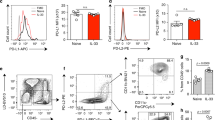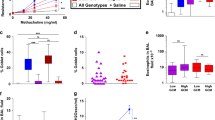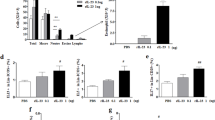Abstract
Asthma is an increasingly common disease that remains poorly understood and difficult to manage. This disease is characterized by airway hyperreactivity (AHR, defined by exaggerated airflow obstruction in response to bronchoconstrictors), mucus overproduction and chronic eosinophilic inflammation1. AHR and mucus overproduction are consistently linked to asthma symptoms and morbidity2,3. Asthma is mediated by Th2 lymphocytes4,5,6,7, which produce a limited repertoire of cytokines, including interleukin-4 (IL-4), IL-5, IL-9 and IL-13. Although each of these cytokines has been implicated in asthma4,5,7,8,9,10,11, IL-13 is now thought to be especially critical. In animal models of allergic asthma, blockade of IL-13 markedly inhibits allergen-induced AHR, mucus production and eosinophilia10,11. Furthermore, IL-13 delivery to the airway causes all of these effects10,11. IL-13 is thus both necessary and sufficient for experimental models of asthma. However, the IL-13-responsive cells causing these effects have not been identified. Here we show that mice lacking signal transducer and activator of transcription 6 (STAT6) were protected from all pulmonary effects of IL-13. Reconstitution of STAT6 only in epithelial cells was sufficient for IL-13-induced AHR and mucus production in the absence of inflammation, fibrosis or other lung pathology. These results demonstrate the importance of direct effects of IL-13 on epithelial cells in causing two central features of asthma.
This is a preview of subscription content, access via your institution
Access options
Subscribe to this journal
Receive 12 print issues and online access
$209.00 per year
only $17.42 per issue
Buy this article
- Purchase on Springer Link
- Instant access to full article PDF
Prices may be subject to local taxes which are calculated during checkout



Similar content being viewed by others

References
Bousquet, J., Jeffery, P.K., Busse, W.W., Johnson, M. & Vignola, A.M. Asthma: from bronchoconstriction to airways inflammation and remodeling. Am. J. Respir. Crit. Care Med. 161, 1720–1745 (2000).
Juniper, E.F., Frith, P.A. & Hargreave, F.E. Airway responsiveness to histamine and methacholine: relationship to minimum treatment to control symptoms of asthma. Thorax 36, 575–579 (1981).
Lange, P., Parner, J., Vestbo, J., Schnohr, P. & Jensen, G. A 15-year follow-up study of ventilatory function in adults with asthma. N. Engl. J. Med. 339, 1194–1200 (1998).
Brusselle, G., Kips, J., Joos, G., Bluethmann, H. & Pauwels, R. Allergen-induced airway inflammation and bronchial responsiveness in wild-type and interleukin-4-deficient mice. Am. J. Respir. Cell Mol. Biol. 12, 254–259 (1995).
Corry, D.B. et al. Interleukin 4, but not interleukin 5 or eosinophils, is required in a murine model of acute airway hyperreactivity. J. Exp. Med. 183, 109–117 (1996).
Gavett, S.H., Chen, X., Finkelman, F. & Wills-Karp, M. Depletion of murine CD4+ T lymphocytes prevents antigen-induced airway hyperreactivity and pulmonary eosinophilia. Am. J. Respir. Cell Mol. Biol. 10, 587–593 (1994).
Lukacs, N.W., Strieter, R.M., Chensue, S.W. & Kunkel, S.L. Interleukin-4-dependent pulmonary eosinophil infiltration in a murine model of asthma. Am. J. Respir. Cell Mol. Biol. 10, 526–532 (1994).
Foster, P.S., Hogan, S.P., Ramsay, A.J., Matthaei, K.I. & Young, I.G. Interleukin 5 deficiency abolishes eosinophilia, airways hyperreactivity, and lung damage in a mouse asthma model. J. Exp. Med. 183, 195–201 (1996).
McLane, M.P. et al. Interleukin-9 promotes allergen-induced eosinophilic inflammation and airway hyperresponsiveness in transgenic mice. Am. J. Respir. Cell Mol. Biol. 19, 713–720 (1998).
Grünig, G. et al. Requirement for IL-13 independently of IL-4 in experimental asthma. Science 282, 2261–2263 (1998).
Wills-Karp, M. et al. Interleukin-13: central mediator of allergic asthma. Science 282, 2258–2261 (1998).
Kuperman, D., Schofield, B., Wills-Karp, M. & Grusby, M.J. Signal transducer and activator of transcription factor 6 (Stat6)-deficient mice are protected from antigen-induced airway hyperresponsiveness and mucus production. J. Exp. Med. 187, 939–948 (1998).
Nelms, K., Keegan, A.D., Zamorano, J., Ryan, J.J. & Paul, W.E. The IL-4 receptor: signaling mechanisms and biologic functions. Annu. Rev. Immunol. 17, 701–738 (1999).
Mullings, R.E. et al. Signal transducer and activator of transcription 6 (STAT-6) expression and function in asthmatic bronchial epithelium. J. Allergy Clin. Immunol. 108, 832–838 (2001).
Stripp, B.R. et al. cis-acting elements that confer lung epithelial cell expression of the CC10 gene. J. Biol. Chem. 267, 14703–14712 (1992).
Kaplan, M.H., Schindler, U., Smiley, S.T. & Grusby, M.J. Stat6 is required for mediating responses to IL-4 and for development of Th2 cells. Immunity 4, 313–319 (1996).
Zhu, Z. et al. Pulmonary expression of interleukin-13 causes inflammation, mucus hypersecretion, subepithelial fibrosis, physiologic abnormalities and eotaxin production. J. Clin. Invest. 103, 779–788 (1999).
Haley, K.J. & Drazen, J.M. Inflammation and airway function in asthma: what you see is not necessarily what you get. Am. J. Respir. Crit. Care Med. 157, 1–3 (1998).
Richter, A. et al. The contribution of interleukin (IL)-4 and IL-13 to the epithelial-mesenchymal trophic unit in asthma. Am. J. Respir. Cell Mol. Biol. 25, 385–391 (2001).
Nakanishi, A. et al. Role of gob-5 in mucus overproduction and airway hyperresponsiveness in asthma. Proc. Natl. Acad. Sci. USA 98, 5175–5180 (2001).
Zheng, T. et al. Inducible targeting of IL-13 to the adult lung causes matrix metalloproteinase- and cathepsin-dependent emphysema. J. Clin. Invest. 106, 1081–1093 (2000).
Moreno, R.H., Hogg, J.C. & Pare, P.D. Mechanics of airway narrowing. Am. Rev. Respir. Dis. 133, 1171–1180 (1986).
Zhu, Z. et al. IL-13-induced chemokine responses in the lung: role of CCR2 in the pathogenesis of IL-13-induced inflammation and remodeling. J. Immunol. 168, 2953–2962 (2002).
Hamelmann, E. et al. Noninvasive measurement of airway responsiveness in allergic mice using barometric plethysmography. Am. J. Respir. Crit. Care Med. 156, 766–775 (1997).
Ordonez, C.L. et al. Mild and moderate asthma is associated with airway goblet cell hyperplasia and abnormalities in mucin gene expression. Am. J. Respir. Crit. Care Med. 163, 517–523 (2001).
Dolganov, G.M. et al. A novel method of gene transcript profiling in airway biopsy homogenates reveals increased expression of a Na+-K+-Cl− cotransporter (NKCC1) in asthmatic subjects. Genome Res. 11, 1473–1483 (2001).
Acknowledgements
We thank A. Atakilit, X.L. Bernstein, R. Ferrando, C. Hoyos, J. Mandac, M. Rodriguez, O. Shcherbakova, P. Woodruff and the staffs of the UCSF-Gladstone Institutes Transgenic Core Facility and the Mouse Physiology Core Facility of the UCSF Sandler Center for Basic Research in Asthma. This work was supported by the National Institutes of Health, the Sandler Family Foundation and the UCSF Howard Hughes Medical Institute Research Resources Program.
Author information
Authors and Affiliations
Corresponding author
Ethics declarations
Competing interests
The authors declare no competing financial interests.
Rights and permissions
About this article
Cite this article
Kuperman, D., Huang, X., Koth, L. et al. Direct effects of interleukin-13 on epithelial cells cause airway hyperreactivity and mucus overproduction in asthma. Nat Med 8, 885–889 (2002). https://doi.org/10.1038/nm734
Received:
Accepted:
Published:
Issue Date:
DOI: https://doi.org/10.1038/nm734
This article is cited by
-
Surfactant protein D prevents mucin overproduction in airway goblet cells via SIRPα
Scientific Reports (2024)
-
SUMOylation of Rho-associated protein kinase 2 induces goblet cell metaplasia in allergic airways
Nature Communications (2023)
-
Intestinal mucus components and secretion mechanisms: what we do and do not know
Experimental & Molecular Medicine (2023)
-
Pathogenesis of allergic diseases and implications for therapeutic interventions
Signal Transduction and Targeted Therapy (2023)
-
MUC5B regulates goblet cell differentiation and reduces inflammation in a murine COPD model
Respiratory Research (2022)


